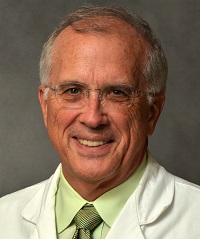
After months of trying to find a solution for her trigeminal neuralgia pain, U of M patient feels she was “finally in the right place”
When Twin Cities resident Deb de Vries (pictured above) reached U of M Neurosurgery Department scheduler Bob Dickhausen, she was at the end of her rope. “It was a Friday afternoon, I had been bounced around by everyone, and had an appointment in another clinic cancelled,” she explained. “When I got Bob on the phone, I was crying. He said to me, ‘Let’s start your profile,’ and promised that I would be called the next week. There was something so comforting about that. He did a great job and it made all the difference.”
Deb called the Neurosurgery Department because she had been diagnosed with a condition known as trigeminal neuralgia (TN) in 2014. The pain created by an artery pressing on her trigeminal nerve – the nerve that carries sensation from the face – was becoming more than she could handle. Like many TN sufferers, Deb had taken several different paths to manage her pain. “I kept going back to my ENT doctor, who corrected a deviated septum and performed sinus surgery on me,” she said. When she finally had an MRI done, the ENT specialist said her sinuses were “picture perfect,” and that she needed to see a neurologist.
“You think I’m nuts,” Deb said, not fully understanding at the time what a neurologist does.
“No, I don’t think you’re nuts, I think you have a nerve issue,” her doctor replied.
Diagnosis made, treatment begins
The neurologist made Deb's trigeminal neuralgia diagnosis and prescribed the anti-seizure medication, carbamazepine, an FDA-approved treatment for the condition. She also tried alternative therapies such as acupuncture and chiropractic to help mitigate the pain. “I believed that they helped for a while because I was so invested in them,” Deb said. “I don’t think they exacerbated the pain. You do a lot of things to help deal with it.”
This past July, she hit a wall. “I was taking the maximum of my anti-seizure meds, which was causing other problems,” Deb said. That was when her primary care physician referred her to Stephen Haines, MD, of the U’s Neurosurgery Department. “I read everything I could about Dr. Haines and felt I was finally in the right place,” she said.

Surgical treatment option
“Deb had typical trigeminal neuralgia symptoms,” said Haines (pictured at left). “We discussed various treatment options, including continuing with medication or performing less invasive, outpatient procedures that allow us to suppress the pain by careful injury of the nerve, which might result in some facial numbness. We also offered her microvascular decompression, which appears to remove the pain’s cause by separating the artery that’s compressing the nerve right where it leaves the brain. In many cases, that will relieve the pain without causing any injury, essentially restoring a patient to normal. That’s the treatment she chose.”
Although Deb was a perfect candidate for the procedure, she wasn’t kidding herself: it was brain surgery, even though no brain tissue would be affected. “When you first hear about this operation, it sounds difficult and dangerous,” Haines said. “It scares many people – and even their doctors who haven’t had much experience with it – away from considering it. It’s not as difficult as anticipated and the result makes it well worthwhile.”
Requires an experienced surgeon
Haines tells his TN patients that the procedure isn’t without risk. “It has potentially serious complications,” he said. “It’s important to be treated by an experienced surgeon who’s been trained to do the procedure in a hospital that does a significant number of them a year. Then things tend to go very well.”
During the surgery in early August 2019, Haines made a small opening in Deb’s skull behind her ear at the site of the pain. “We entered the membrane under the bone and went into the spinal fluid space around the brain,” he explained. “That’s where the nerve and the artery are, so the procedure doesn’t disturb brain tissue. We moved the artery away from the nerve, being careful not to kink it or any of its branches. We then placed a fibrous Teflon pad in a way that prevents the artery from flipping back into that space. When that was done, we put everything back together.”
Teflon felt has been successfully used in cardiac surgery for decades and can be safely left in the body, according to Haines. For this application, the fibers of the pad are “fluffed up,” making it look like the end of a Q-tip that’s been separated from its stick.
Woke up with no pain
The procedure went well. “I woke up from the surgery with no pain,” said Deb. “Although I don’t recall it, my family said I was laughing and smiling. I didn’t even need pain meds. I felt great.”
When she returned home, Deb was unequivocal about her post-operative response. “It’s a game changer! I can smile as spontaneously and as wide as I want,” she said. “I can speak, I can bite into food, chew on both sides of my jaw, I can blow my nose, I can sleep on my side rather than my back, I can splash water on my face, I can get a facial, I can have the wind hit my face, I can brush my teeth on both sides of my mouth. And while I can’t say I am looking forward to going to the dentist, I can do it with a level of confidence that it won’t aggravate a nerve in my face.”
These things that Deb says she can now do are what trigeminal neuralgia sufferers typically can’t without triggering shocking spasms of facial pain. “I had been used to making accommodations and muscling my way through daily events,” said Deb. “The realization that I don’t have to do that anymore is incredible if not still unbelievable to me. Dr. Haines told me that it would take me at least a couple of months to fully trust the results of the surgery.”
LIttle known about TN
Throughout the entire process of suffering, trying to find out why, and then being diagnosed, Deb was surprised by how little people know about trigeminal neuralgia. “Unfortunately, many people go years before getting an accurate diagnosis,” said Haines. “There is a lack of knowledge about the condition and how to diagnose it. The Facial Pain Association, which has been in existence since 1990, has done a lot of work to spread information about the disease and its symptoms to both the medical and dental communities.”
Deb has a pervading sense that TN sufferers are simply not believed. “Maybe it’s because the incredible pain symptoms do not appear at the outset of the condition, which for some reason, makes it manageable,” she said. “And maybe because it can be tolerated for a while, it is not treated as seriously or as immediately as it needs to be. Toleration is like the old story of the frog – if you put him in boiling water, the frog will jump out immediately…but if you slowly turn the water up until it boils, he will stay and ultimately die.”
Deb appreciates the entire University of Minnesota neurosurgical team who enabled her to jump out of her metaphorical pot of hot water, “but I will be forever grateful to Dr. Haines!”
More information about the Facial Pain Association.
To schedule an appointment with the U’s Facial Pain Clinic, call 612-624-6666. To refer a patient, call 612‑672‑7000.
To contact the Twin Cities Facial Pain Support Group, email Rene Johnson, facialpainmn@gmail.com.



